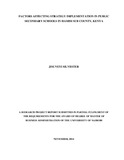| dc.description.abstract | Effective strategies are bound to fail or succeed depending of on how implementing agencies
monitor, evaluate and constantly manage factors both in immediate internal and external
environment of the organization. In relation to this, the objective sought to investigate the
factors that influenced strategy implementation among secondary schools in Hamisi SubCounty
in Vihiga County. In achieving this, the study adopted cross-sectional descriptive
research design. Data were collected from all the 47 public secondary schools in Hamisi Subcounty
from the school principals, their deputies and senior teachers. The data were analyzed
by descriptive statistics and factor analysis. Results of analysis showed that stakeholder
involvement in strategy implementation, human resource empowerment, institutional culture
and structure, commitment by top management, institutional policies, determination of
activity timelines, clear definition of school strategic activities, incorporation of contingency
planning, and how strategy implementation roles are shared among the teams, are the most
significant factors affecting strategy implementation among public secondary schools in
Hamisi Sub-county. The stakeholder involvement factor is composed of rewarding
approaches adopted to induce the teachers, internal relationships among the learning parties
(students, teachers and parents), internal communication policy, disbursement of funding
from the Government and other donor stakeholders, and the health statuses of the parents and
institutions in the neighbourhood. Empowerment of human resource component factors
include teacher empowerment concerns, quality of directions disseminated from
management, easy adoption to strategic changes, and degree of independence among school
sections and departments. The cultural orientation factor was found to constitute
compatibility between strategy and schools values/beliefs, and the schools’ involvement in
corporate social activities, commitment of top level managers in strategy implementation was
reflected by the setting of performance indicators by the managers, day-to-day decision
making by management, and BoM’s commitment towards group goal realization. The study
recommends that schools identify and popularize their strategic priorities by predominantly
engaging all of their primary stakeholders in establishing a collective framework towards
goal attainment. This advocates for incorporation of stakeholder theory in consolidating
internal and external resources towards effective strategy implementation. Moreover, the
study recommends emphasis on management commitment by other stakeholders to ensure
that deviations from preset target are minimal. Finally, managements in the different schools
are advised to drive the strategy implementation exercise on solid formulation foundation and
contingency planning, based on stakeholder engagement, resource mobilization,
benchmarking, and milestone monitoring and evaluation. Alongside these findings, the study
acknowledges limitations of factor-inclusion, limited-contextual scope weaknesses, and size
of explained variance which are pertinent considerations for future research in similar
contextual and conceptual perspectives | en_US |

